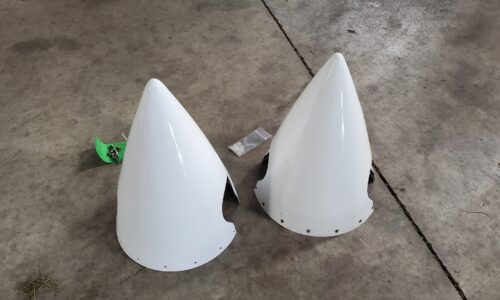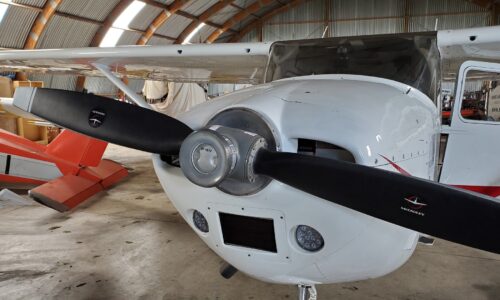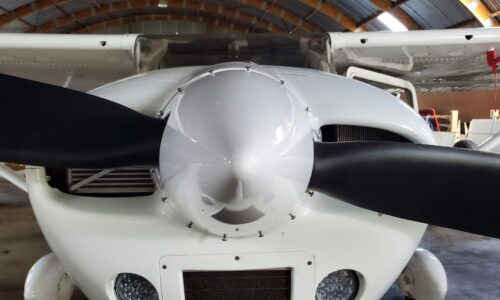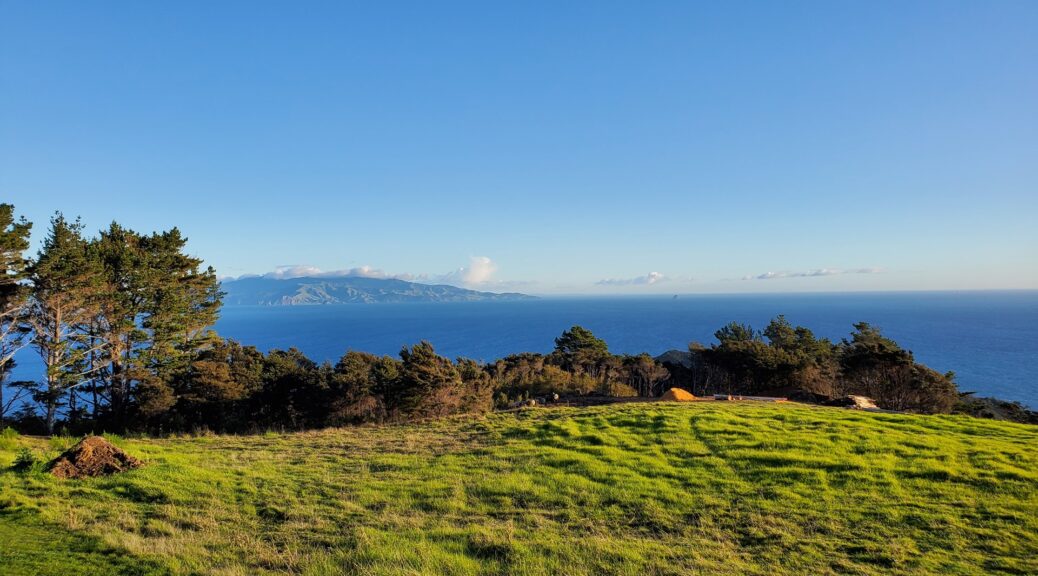Round the World – New Zealand 2, Part 1
After two weeks in quarantine it felt very strange to be standing on the street in Auckland, not wearing a mask and free to go on with my day. I jumped on a bus back out to the international airport to go and collect my rental car; given the lack of tourists some truly excellent deals had been available. Half way to the airport the bus broke down. Things were off to a typical 2020 start.
After collecting my car I headed straight to the airport. I was keen to see Planey after so many months away from him! Warbirds had looked after him very well and he was tucked safely behind a C180 in one of their hangars. After checking on him I dropped off the new spinner with Oceania Aviation to be painted and settled in to relax for a while at my AirBNB.
A couple of days later the spinner was ready! I returned to the hangar and performed the swap, which was then checked and signed off by an FAA certified inspector. Despite the old spinner being aluminium and the new being composite, they weighed exactly the same; this came as a surprise to me, but negated the need to update the weight and balance calculations.
A couple of days after fitting the spinner it was time to finalise the annual inspection at Oceania Aviation. I removed the interior and Shaun completed the remaining inspection items before organising the sign-off from the FAA certified inspector. With all the paperwork taken care of, and Planey legal to fly again, I tucked him into a hangar kindly offered up for a few days by Blair Huston.
That afternoon I paid another visit to the folks at Warbirds. They’d been hosting a corporate day with four of their Harvards taking people on formation scenic flights. They also had several of their World War One collection out for engine runs; the noise of radial engines at close range with no exhaust system was fairly overwhelming!
For my first flight destination now that I was back in New Zealand, I settled on Great Barrier Island. This island sits at the entrance to the Hauraki Gulf and is the fourth largest island of New Zealand’s main island chain, with about 1,000 inhabitants. It’s only about 60 miles (100km) from Auckland, making it a short and simple flight in the C182. The weather was ideal for the flight out; direct VFR routing over the gulf, with an overhead join above Claris airport. I pulled up in front of the terminal and checked with the staff about where to park; nobody was sure, so they phoned the manager. Not realising that he was on speakerphone, he confirmed that I was fine to park on the grass because the NOTAM forbidding it was just to stop “those bloody commercial operators”, or words to that effect!

The local rental car operator was already waiting, and handed me the keys to a tired but serviceable 4×4. I had found a “bach” (pronounced “batch”) for rent; a traditional New Zealand holiday home, typically a modest beach hut. This one was no exception; slightly ramshackle but comfortable, with solar power (there is no central power on the island) and rainwater collection for the water system. The fridge and cooking ran on gas power, as did the hot shower. There was a wood stove with a small supply of ready-cut wood; this was to be a welcome feature, as the temperature still dropped pretty low at night at this time of year. The view out over the beautiful beach of Oruawhaho Bay was stunning.
There was still plenty of daylight left so I set out for a little exploring of the island. With few tourists around and a small population traffic was light, and most drivers would wave to each other as they passed. My destination on this first afternoon was the town of Tryphena near the southern end of the island. After stopping to buy a few supplies from the general store, priced much higher than on the mainland, I continued my drive west into the hills. I soon happened across a ramshackle building by the side of the road signposted as an artist’s studio and gallery. Intrigued, I parked the car on the steep road, a little worried about how well the parking brake might hold, and entered. Nobody was around but all the paintings and sculptures were on open display, with details of where to send a bank transfer if you wanted to take something with you!
I returned to Tryphena for dinner and ended up at an Irish bar; options on the island were limited, but this establishment turned out to have exceptional food and a great atmosphere! The lasagna was apparently renowned, and after tasting it I could see why; dessert of course had to be the “Death by Chocolate”. A hundred meters into my drive home I passed a Frenchman who had been in the bar, and was now trying to hitchhike across the island – optimistic perhaps, with such little traffic. It worked, however, as I picked him up and we chatted as I drove him home; he was on vacation while his partner and child remained back home in the South Island, and he had extended his stay from 3 day to 2 weeks and counting. He was clearly enjoying some peace and quiet.
The temperature had dropped dramatically. The bach was the other side of a river ford which I was not willing to chance the rental car in. I hurried over the footbridge and up the hill to the bach, getting a fire going in the wood stove to warm things up. I was thankful for the warm blankets that night.
The next day I drove north, back towards the airport. The sun was bright and there was barely a cloud in the sky. I passed somebody’s laundry basket, complete with laundry, in the other lane of the road; that was a little strange and I presumed that they’d shortly be driving back this way to try and work out what had happened to it. My first stop was back near the airport at the GBI Community Heritage and Arts Village; a collection of historical buildings and artist studio. This organisation is housed in a collection of historic buildings from as long ago as 1908; pretty old in New Zealand terms! The art collection was excellent, all by local GBI artists, and reflecting the landscapes and moods of the barrier island.
From here I drove north again, making my way towards the tip of the island and the hamlet of Kawa. My main reason for visiting here was to have a look at the grave sites of some of the crew and passengers of the ill-fated ship S.S. Wairarapa. This 280ft steamer serviced the route between Auckland and Australia in the late 19th century and was just 12 years old when it ran aground on a foggy night, running full speed into rocks on the shore of Great Barrier Island. Around 130 of those on board lost their lives; one of the lifeboats reached a local Maori community who immediately assisted, saving the lives of many who might have otherwise drowned. Given the limited communications at the time it was three days before news of the wreck even reached Auckland.
Those victims who were recovered are now buried at two main sites on GBI, and Kawa is one of these. To reach the site takes some scrambling along the rocks of the shoreline, which are covered in thousands upon thousands of tiny snails; despite my best efforts a few met their unfortunate end under my shoes. The burial plot is tucked into a small cove overlooking the ocean; a small bach is perched a few yards up the beach, which must have been quite an effort to construct.
I drove back along the winding dirt road and rejoined the sealed pavement, heading west to Port Fitzroy. There is a small port here (as the name suggests) and while I was enjoying the views a yacht arrived and unloaded some passengers from a day tour. A friendly dog was running around and came up to say hello before continuing on his way, following a variety of presumably interesting aromas.
Port Fitzroy is home to the Glenfern Sanctuary. This is the main entry point to the 240 hectare, predator-fenced Kotuku peninsula. New Zealand has no native mammals and after its’ “discovery” by Europeans the settlers rapidly introduced animals that made them feel at home; cats, rabbits for hunting, stoats and weasel to catch the rabbits, and rats that stowed away on ships. All of these imported animals found that the native birdlife, defenseless against the foreign predators, were an easy target for a meal, and the native populations plummeted. Multiple projects around New Zealand are now set up to create predator-free zones, fenced off from these threats, and Glenfern sanctuary has a long walking loop trail up into the hills to enjoy the native bush as it used to be.
Near the highest point of the loop track is a Kauri tree. The largest tree in New Zealand (by volume, although not by height), the vast majority of the Kauri were logged by settlers and just a small fraction of the original number remain. This particular Kauri at Glenfern has a walkway built from the mountainside leading across into the crown of the tree, and spectacular views are to be enjoyed once one crosses the walkway and climbs the ladder into the highest section.
The continuation of the loop track leaves the forest and heads down through more open fields. One of these was home to a number of young cattle who advanced towards me with curious expressions on their faces; not that I’m an expert in bovine facial expressions. It was a little intimidating to be so close to such large and potentially playful animals; even juveniles are quite massive compared to a fragile human being like me! Thankfully they settled for just taking a look as I walked tentatively past.
Driving back towards the bach I noticed a cheeky signpost, “Donald Trump”, pointing towards the island’s garbage dump. Dinner that evening was back at the Currach again; but, disaster, they were out of lasagna!
To kick off my last full day on the island I hiked out to the Kaitoke hot springs. Being a very geologically active country, New Zealand has all kind of geothermal features such as hot springs dotted around the landscape. The walk to Kaitoke takes about 45 minutes along a well graded trail/boardwalk combination. As I reached the pools three young hikers were just finishing their bathing; they’d been out at the island for a long weekend, carrying out a three day hike which ended not far beyond the springs. As they headed off I settled in to relax in the warm water for a while. Being a natural, unimproved hot springs they were quite murky with decaying plant matter covering the bottom, but were still a pleasant way to spend a while sitting and watching birds flitting through the bush.
Lunch was at the “My Fat Puku” cafe which was well attended for a weekday afternoon. The walkers from the hot springs arrived shortly after I’d started on my Thai chicken dish, looking quite happy to have finished their three day hike which had apparently been blessed with good weather the entire time.
The evening was cold once again with the wood stove doing sterling work!
The run of good weather had broken and I woke up periodically during the night, listening to heavy rain beating down on the corrugated metal roof of the bach. I had rather complacently left my waterproofs in the car, lulled into a false sense of security by the beautiful weather of the last few days. Improvisation saved the day and I created a set of waterproof clothes and luggage covers out of black plastic rubbish bags and set off down the hill. The rain stopped seconds after I stepped out of the front door.

Conditions were poor and the only way to get out would be on an instrument flight plan; accordingly, I filed one online. A few minutes later the lady behind the commercial flight counter stood up and shouted out, “Is anyone here a pilot?” I decided to answer in the affirmative, pleased that my skills were finally in demand; but it turned out to just be that air traffic control wanted to confirm a few details about my flight plan. I started up and taxied to the run-up bay. As I waited for the engine oil to come up to temperature I could hear the Great Barrier Air Cessna Caravan attempting to make a landing; after two missed approaches they finally made it in and taxied to the terminal as I headed out to the runway.

There was a strong wind from the southwest causing heavy turbulence, and it was a bumpy ride through the clouds back towards Ardmore. I tucked Planey back into his hangar with the first trip back in New Zealand successfully completed.
Click here to read the next part of the story.












































